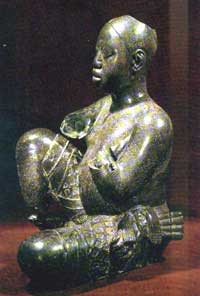
TSOEDE BRONZES

The bronzes are divided into four groups. The first consists of the so-called Gara figures, two on Jebba Island, a male and a female, and one in Tada.
The second group consists of only the seated figure shown here, perhaps the most important naturalistic sculpture in Black Africa. Two other more recent-looking figures make up the third group, while the figures of two ostriches and an elephant form the fourth group. The male Jebba Gara figure better known as the Jebba Bowman and the Tada Gara male figure are believed to bear resemblance to Benin works because of the diadems on their foreheads which depict faces with snakes issuing from their nostrils, a common feature in Benin works. The Tada seated figure seems, in its naturalism and rigidity, to belong to the Ife school. The two more recent looking figures from Tada have a combination of Yoruba and Benin traits while the ostriches and the elephant belong to a yet unidentified school. So, here we find at least four traditions of sculpture in bronze and their coming together suggests that they were accidentally assembled.
All the figures were still being used in rituals, in secondary contexts, in the places where they were located until they were temporarily taken into safety in the National Museum in Lagos.
Ricerca Ing. F.P. Di Giacomo - Dati e cartografia in internet: Alpha Consult S.r.l - Web: G. Cerica |
|||